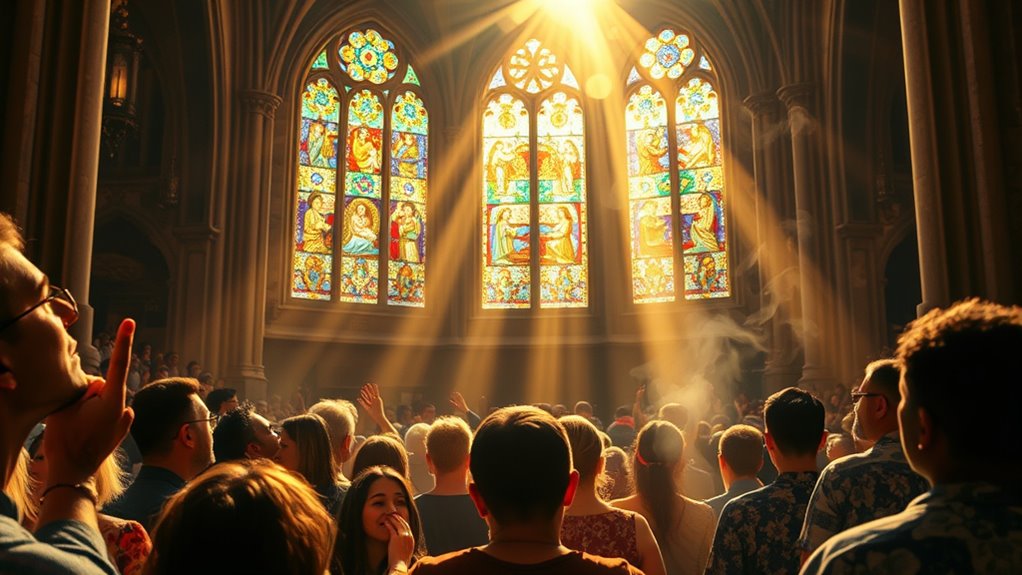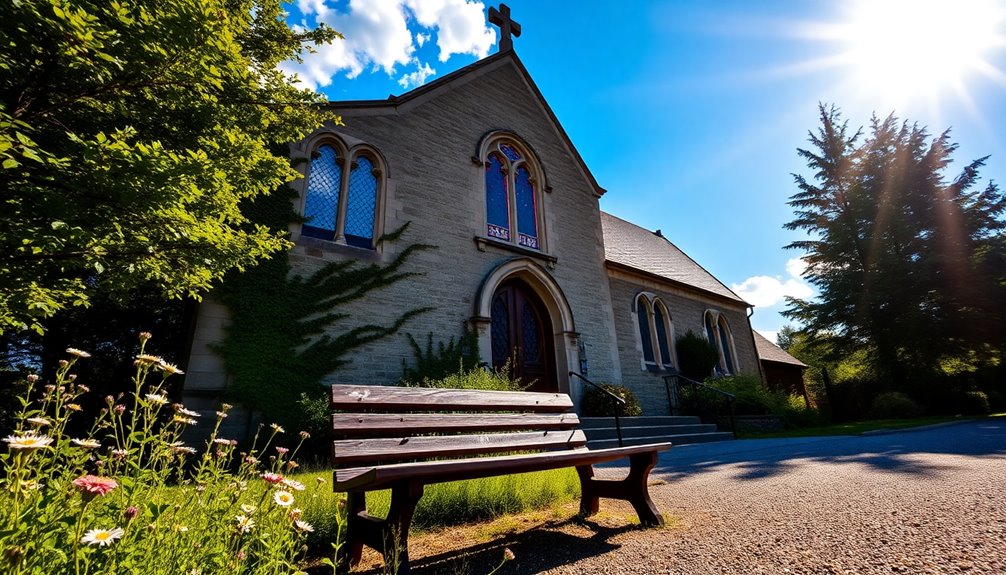Revival is a spiritual awakening that renews faith and energizes communities, often sparking societal and cultural change. Throughout history, movements like the Great Awakening or Welsh Revival ignited passion and transformed societies through prayer, emotional sermons, and social action. Today, similar movements focus on personal growth, mindfulness, and community involvement, inspiring hope and resilience. If you want to understand how these awakening moments shape lives and societies, there’s more to discover ahead.
Key Takeaways
- Revival is a spiritual awakening that renews faith, purpose, and community cohesion, often leading to societal and cultural shifts.
- Historically, revivals like the Great Awakening and Welsh Revival revitalized faith through emotional worship and social change.
- Modern revivals incorporate practices like meditation, mindfulness, and community engagement to foster personal growth and resilience.
- Indicators of revival include increased prayer, genuine repentance, outward faith expressions, and inspired leadership.
- Revivals influence arts, social justice, and reforms, serving as catalysts for societal transformation and lasting cultural impact.
Defining the Concept of Revival
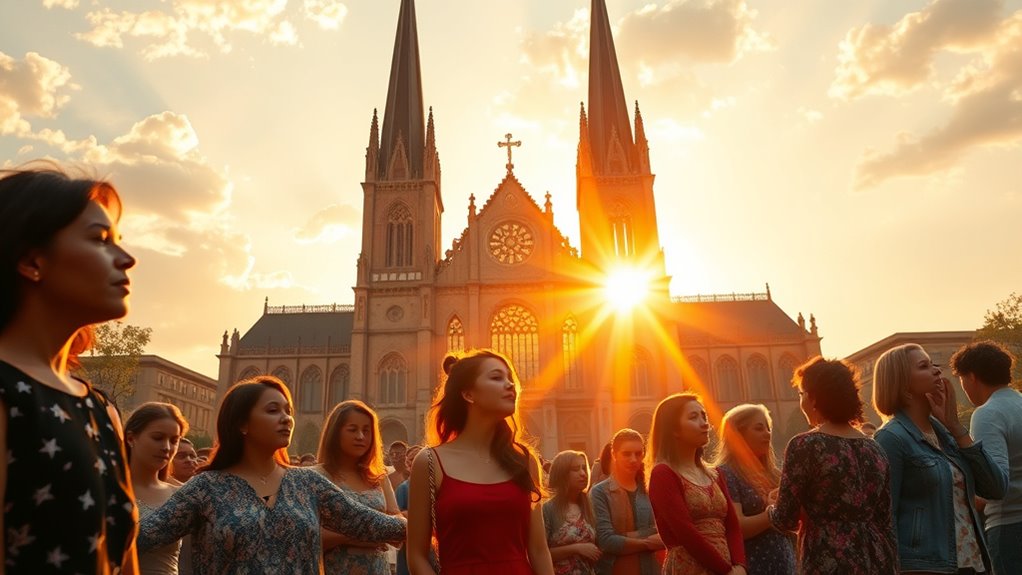
A revival is a renewed spiritual awakening that energizes a community or individual, often leading to a deeper sense of faith and purpose. This phenomenon is frequently discussed within theology debates, where different perspectives interpret what truly sparks such renewal. Revival terminology varies, but common themes include spiritual renewal, renewal of faith, and divine intervention. You might hear terms like “revivalism” or “outpouring,” which capture the intensity and immediacy of these events. Understanding revival involves recognizing it as more than just a church meeting—it’s a profound shift in spiritual life that revitalizes believers and often attracts new followers. While definitions may differ, the core idea remains consistent: it’s a powerful, transformative experience rooted in faith. Additionally, the role of Gold IRA Rollovers and other financial strategies underscores the importance of preparation and stability, which can parallel the spiritual readiness fostered by revival experiences. Being aware of how state-specific tax laws influence financial planning can help believers ensure their resources are aligned with their spiritual and life goals. Recognizing the influence of adaptive learning technologies in spiritual education can also enhance understanding and engagement during revival movements. Moreover, historical revivals demonstrate that such awakenings often involve significant social and cultural shifts that impact entire communities beyond individual faith.
Historical Examples of Major Spiritual Movements
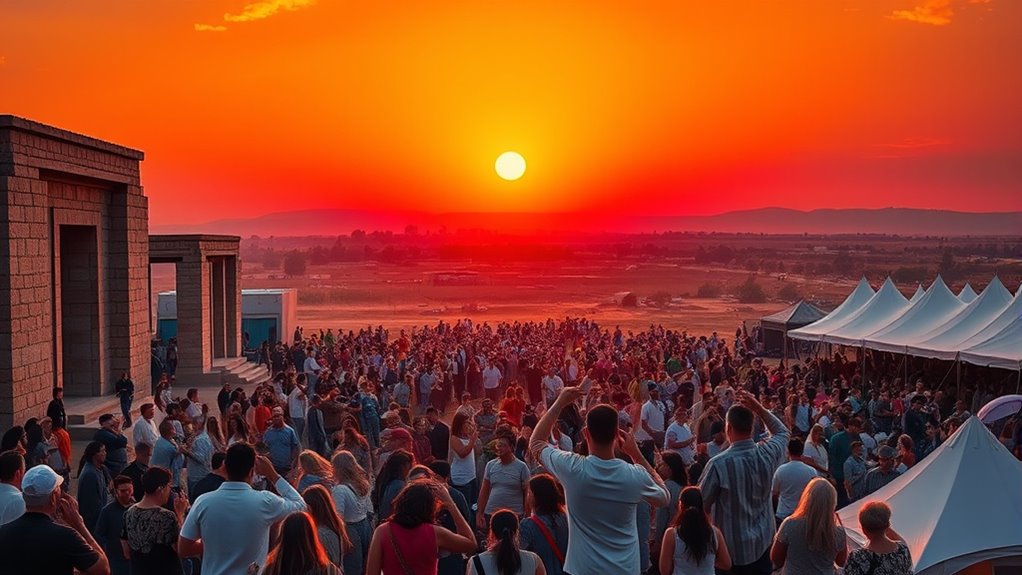
Throughout history, major spiritual movements have ignited profound transformations within societies, shaping cultures and inspiring millions. These movements used revival strategies like passionate preaching, communal worship, and innovative revival in art to spark renewal. One striking example is the Great Awakening, which revitalized faith through emotional sermons. The Azusa Street Revival ignited Pentecostalism with fervent prayer and healing. The Welsh Revival emphasized prayer and social change, influencing entire communities. These movements show how revival in art—through music, painting, and literature—can deepen spiritual impact, stirring hearts and minds. Moreover, the incorporation of artistic expression such as music and visual arts into worship can significantly enhance emotional and spiritual engagement, making revival efforts more impactful. Additionally, the use of revival techniques like emotional storytelling and community involvement played a crucial role in sustaining these movements. The success of these spiritual revivals often depended on their ability to adapt to the cultural contexts of their time, demonstrating the importance of cultural relevance in revival strategies. For example, the use of modern media helped spread messages rapidly and reach wider audiences, amplifying their influence. Such examples prove that revival strategies are versatile and powerful, capable of transforming individual lives and entire societies.
Characteristics That Signal a Revival

Recognizing the signs of a revival requires attentiveness to specific characteristics that signal spiritual renewal is underway. One key revival signal is a noticeable surge in personal traits like renewed passion, humility, and a deep sense of longing for God. People often display increased prayer, worship, and a desire to share their faith authentically. You might observe a collective sense of brokenness and repentance, reflecting genuine change at the individual level. Revival signals also include a heightened awareness of spiritual needs and a willingness to seek deeper truth. These traits demonstrate an inward transformation that naturally overflows into outward expressions of faith. Additionally, the emergence of trustworthiness in leadership and a focus on safety measures can foster an environment conducive to revival. When you notice these personal traits emerging across communities, it often indicates that a spiritual awakening is beginning to take hold. Recognizing these signs can help believers foster a conducive environment for spiritual growth and renewal, emphasizing the importance of authentic spiritual transformation as a foundation for lasting revival. Furthermore, an increased sense of spiritual discernment among believers can serve as a vital indicator of an ongoing revival. The presence of consistent faith-based actions within communities further confirms that revival is taking root and gaining momentum.
The Role of Leaders and Communities

Leaders play a pivotal role in inspiring and guiding spiritual awakenings, shaping the direction of revival efforts. Community engagement fuels these movements, creating a sense of shared purpose and momentum. When leaders mobilize their communities effectively, they can ignite lasting spiritual transformations that resonate widely. Recognizing the importance of feature Buddies can also facilitate collaboration and sustained growth within these movements, especially as sound design techniques can be used to enhance communal experiences and events. Additionally, applying principles of mindful decluttering may help communities focus on meaningful practices and shared goals during revival periods. Utilizing AI Content Clusters to organize related themes can further deepen engagement and streamline efforts in fostering these spiritual movements. Moreover, understanding Ring Security Cameras features, such as maintaining device connectivity and preventing environmental issues, can be applied metaphorically to ensure the resilience and security of community initiatives during revival efforts.
Leadership’s Influence on Revival
When a community seeks revival, the influence of leaders becomes a powerful catalyst for change. Your leadership style can inspire hope, direct focus, and mobilize others toward spiritual renewal. Effective revival catalysts often exhibit qualities like passion, humility, and vision, creating an environment where transformation can flourish. Leaders who embrace authentic communication and demonstrate unwavering faith inspire trust and motivate communities to pursue renewal. By setting the tone and modeling spiritual fervor, you help ignite a collective desire for change. Your influence can spark the initial spark that leads to widespread awakening, making leadership an essential element in shaping the trajectory of revival. Recognizing the importance of spiritual leadership qualities can also inspire innovative approaches to spiritual leadership and community engagement. Cultivating an environment of trust and authenticity is crucial for fostering sustained revival efforts. Incorporating leadership styles that emphasize empathy and connection can significantly enhance the impact of revival initiatives. Additionally, understanding ice cream consumption trends can serve as a metaphor for how communities can embrace new flavors of faith and renewal to keep spiritual life vibrant and engaging. Furthermore, applying canvas waterproofing techniques from camping can symbolize the importance of protecting and nurturing spiritual growth against external challenges.
Community Engagement Dynamics
Community engagement plays a crucial role in sustaining and amplifying spiritual revival, as active participation from both leaders and members creates a dynamic environment for growth. When people are genuinely involved, faith formation deepens, fostering a shared sense of purpose and renewal. Leaders who encourage open dialogue and collective worship help nurture trust and commitment, fueling congregational growth. As community members take ownership of their spiritual journey, they inspire others to join, creating a ripple effect that sustains momentum. This active engagement ensures that revival isn’t just a fleeting event but a lasting transformation rooted in shared experiences. By prioritizing community participation, you lay a foundation where faith can flourish, and the revival’s impact can extend beyond individual hearts to entire congregations.
Mobilizing Spiritual Movements
Mobilizing spiritual movements requires intentional coordination between leaders and communities to ignite lasting change. Leaders play a crucial role in inspiring church outreach and organizing prayer initiatives that draw people together. When communities unite with a shared purpose, revival becomes more than an event—it transforms lives. Effective mobilization involves clear communication, strategic planning, and fostering a sense of ownership among participants. Consider how different roles contribute to the movement:
| Leadership Actions | Community Engagement |
|---|---|
| Organize prayer initiatives | Participate actively in outreach programs |
| Inspire through sermons and teachings | Support church activities and outreach efforts |
| Coordinate training and revival events | Invite others to join the movement |
Additionally, incorporating spiritual growth practices such as prayer and meditation can deepen individuals’ connection to the movement and enhance its overall impact.
Fostering emotional support within the community can strengthen bonds and sustain enthusiasm during challenging times. Together, leaders and communities create momentum that sustains spiritual awakening.
Impact of Revivals on Society and Culture

Revivals often serve as catalysts for profound societal and cultural shifts, inspiring new values, behaviors, and artistic expressions. They can influence the secular domain by promoting ideas that challenge traditional norms, leading to increased openness or reform. These movements often have political implications, as revived spiritual ideals can inspire activism or shape legislation aligned with new moral priorities. For example, a revival might encourage social justice efforts or influence policy debates on issues like education or civil rights. As a result, societal institutions may adapt or transform, reflecting the renewed spiritual energy. You might notice how these movements ripple through culture, affecting everything from art and music to community practices, ultimately shaping the broader societal landscape long after the initial awakening.
Modern-Day Spiritual Awakenings

In recent years, a wave of spiritual awakenings has gained momentum across diverse populations, driven by a desire for deeper meaning and personal growth. Today’s seekers turn to meditation practices to quiet their minds and connect with their inner selves. These modern awakenings often emerge through mindfulness, journaling, and retreats, inspiring transformation. You may find yourself exploring new spiritual paths, seeking authenticity, and embracing vulnerability. The table below captures some common feelings and experiences during this journey:
| Feeling | Experience | Outcome |
|---|---|---|
| Inner peace | Meditation brings clarity | Greater emotional stability |
| Self-awareness | Reflection uncovers truths | Personal growth |
| Connection | Shared practices foster community | Reduced loneliness |
| Empowerment | Overcoming doubts | Confidence in your path |
| Resilience | Embracing change | Stronger sense of purpose |
The Enduring Significance of Revival Movements
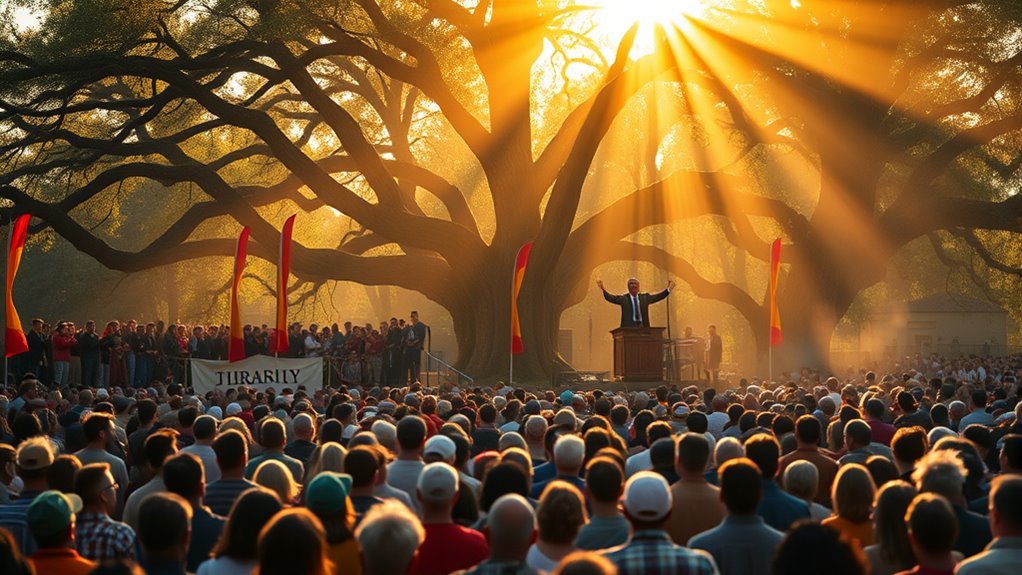
Revival movements have persisted throughout history because they fulfill a fundamental need for renewal and collective purpose. Their psychological impact is powerful, often inspiring hope, unity, and a renewed sense of faith among individuals. These movements can transform communities by fostering a shared identity and resilience during challenging times. Additionally, revival’s economic influence is significant; increased participation in religious activities often boosts local economies through events, gatherings, and related industries. Revivals also stimulate social cohesion, encouraging community service and charitable efforts. This enduring significance lies in their ability to energize societies, reinforce cultural values, and spark positive change. Whether in ancient or modern contexts, revival movements continue to shape collective consciousness and influence societal development in profound ways.
Frequently Asked Questions
How Do Revivals Differ Across Various Religious Traditions?
You’ll notice that revivals differ across religious traditions through their focus on doctrinal renewal and community engagement. In some faiths, revivals emphasize interfaith dialogue, fostering unity and understanding. Others prioritize returning to core teachings or spiritual practices. These differences shape how each tradition experiences awakening, but all aim to inspire growth, renew faith, and deepen connections within their communities. Recognizing these nuances helps you appreciate the unique ways religions seek renewal.
Can Revival Movements Occur Simultaneously in Different Regions?
You might wonder if revival movements can happen at the same time in different regions. Yes, regional synchronization is possible, especially when cultural influences align across areas. When shared societal issues or global events occur, they can spark spiritual awakenings simultaneously. This interconnectedness means that revival movements often spread quickly, inspiring multiple regions to experience renewal together, despite geographical distances or cultural differences.
What Psychological Factors Contribute to Spiritual Awakenings?
Imagine a gentle breeze stirring a calm lake—that’s how emotional triggers spark spiritual awakenings. You’re often influenced by collective consciousness, where shared feelings and thoughts create a fertile ground for change. These psychological factors, like heightened emotions or a sense of connection, open your heart to new insights. By tuning into these subtle currents, you experience a shift that awakens your spirit and deepens your understanding of life’s purpose.
Are Revivals Typically Spontaneous or Planned Events?
You might wonder if revivals are spontaneous or planned. Usually, they’re a mix, sparked by a sudden emotional revival or a planned faith renewal event. Sometimes, a community experiences an unexpected awakening, leading to spontaneous revival. Other times, leaders organize intentional gatherings to foster spiritual growth. Regardless, both types aim to inspire deep faith renewal and emotional revival, revitalizing individuals and communities through heartfelt spiritual experiences.
How Do Modern Technologies Influence Contemporary Spiritual Revivals?
Some might think modern technologies limit genuine spiritual revival, but they actually amplify it. Digital faith and social media create opportunities for more people to engage in spiritual conversations, share testimonies, and organize events instantly. You can reach a global audience, fostering a sense of community and urgency. These tools make contemporary revivals more accessible, dynamic, and impactful, helping you connect deeply with faith in ways previously unimaginable.
Conclusion
Understanding revival means recognizing its power to transform lives and societies, much like how the printing press sparked spiritual awakenings in the past. Today, you can witness these moments of renewal in unexpected places, from social media revivals to community gatherings. Just like in the Renaissance, revival isn’t just history; it’s a living, breathing force that can inspire change now and tomorrow. Embrace it, and be part of this ongoing story of renewal.

